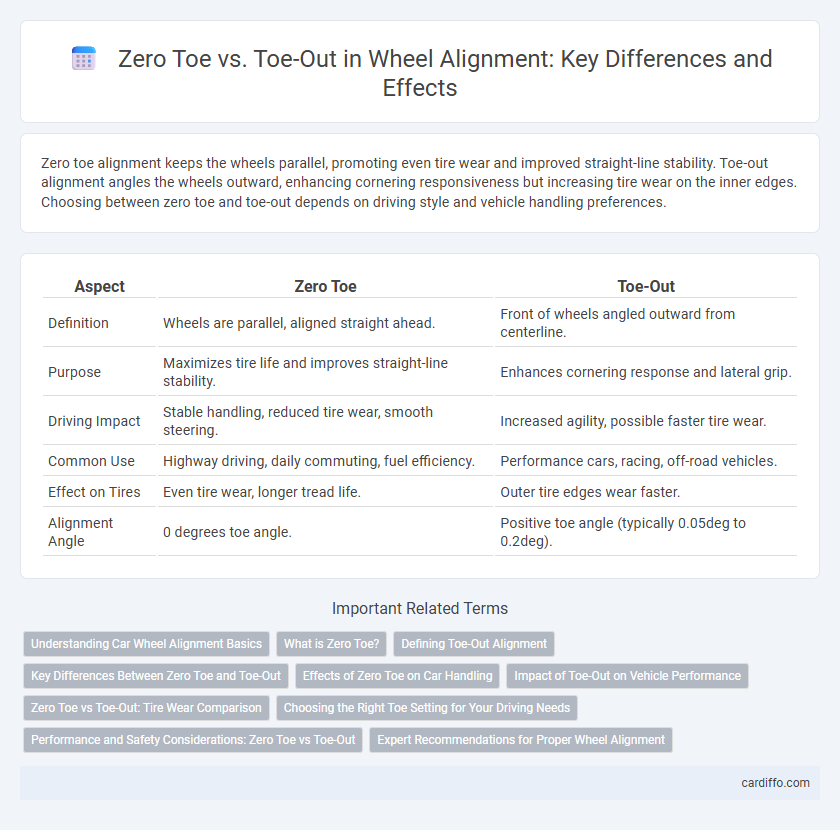Zero toe alignment keeps the wheels parallel, promoting even tire wear and improved straight-line stability. Toe-out alignment angles the wheels outward, enhancing cornering responsiveness but increasing tire wear on the inner edges. Choosing between zero toe and toe-out depends on driving style and vehicle handling preferences.
Table of Comparison
| Aspect | Zero Toe | Toe-Out |
|---|---|---|
| Definition | Wheels are parallel, aligned straight ahead. | Front of wheels angled outward from centerline. |
| Purpose | Maximizes tire life and improves straight-line stability. | Enhances cornering response and lateral grip. |
| Driving Impact | Stable handling, reduced tire wear, smooth steering. | Increased agility, possible faster tire wear. |
| Common Use | Highway driving, daily commuting, fuel efficiency. | Performance cars, racing, off-road vehicles. |
| Effect on Tires | Even tire wear, longer tread life. | Outer tire edges wear faster. |
| Alignment Angle | 0 degrees toe angle. | Positive toe angle (typically 0.05deg to 0.2deg). |
Understanding Car Wheel Alignment Basics
Zero toe alignment positions the wheels parallel to each other, enhancing straight-line stability and reducing tire wear by minimizing lateral tire scrubbing. Toe-out alignment angles the front of the wheels slightly outward, improving cornering response and steering agility but potentially increasing tire wear during straight driving. Understanding these differences helps optimize vehicle handling characteristics and extend tire lifespan based on driving conditions.
What is Zero Toe?
Zero toe refers to the alignment setting where the front edges of the tires point perfectly parallel to each other, without angling inward or outward. This alignment configuration minimizes tire wear and promotes even distribution of tire contact with the road. Maintaining zero toe enhances vehicle stability, steering response, and fuel efficiency by reducing rolling resistance.
Defining Toe-Out Alignment
Toe-out alignment refers to the condition where the front edges of the wheels point outward, away from the vehicle's centerline, creating a slight outward angle. This setup can enhance cornering response and steering stability by increasing the tire's contact patch during turns. Compared to zero toe, which aligns wheels parallel to the centerline, toe-out influences tire wear patterns and vehicle handling dynamics.
Key Differences Between Zero Toe and Toe-Out
Zero toe alignment places the wheels parallel to the vehicle's centerline, ensuring straight tire positioning for optimal straight-line stability and even tire wear. Toe-out alignment angles the front of the wheels away from the centerline, enhancing cornering responsiveness and steering agility but potentially causing increased tire wear on the inner edges. The key differences lie in their impact on handling characteristics and tire longevity, with zero toe favoring stability and tire preservation, while toe-out prioritizes sharper turn-in and maneuverability.
Effects of Zero Toe on Car Handling
Zero toe alignment keeps the wheels parallel during driving, enhancing straight-line stability and reducing uneven tire wear. This setup improves fuel efficiency by minimizing rolling resistance, making it ideal for highway driving. However, zero toe can lead to less responsive steering and reduced cornering grip compared to toe-out configurations.
Impact of Toe-Out on Vehicle Performance
Toe-out alignment increases the steering response and improves cornering agility by allowing the front wheels to point slightly away from the centerline, which enhances vehicle control during turns. This setup can cause increased tire wear and reduced straight-line stability due to the additional lateral forces acting on the tires. Proper toe-out adjustment is crucial for performance vehicles aiming for sharper handling without compromising tire longevity.
Zero Toe vs Toe-Out: Tire Wear Comparison
Zero toe alignment minimizes tire scrubbing by keeping the wheels parallel, significantly reducing uneven tire wear and extending tire life. Toe-out alignment causes the front of the tires to point away from the vehicle centerline, leading to increased edge wear and accelerated tread degradation, especially on the inner or outer edges. Comparing both, zero toe is generally more effective at preserving tire tread evenly, while toe-out increases the risk of premature tire replacement due to uneven wear patterns.
Choosing the Right Toe Setting for Your Driving Needs
Selecting the right toe setting--zero toe or toe-out--depends on your specific driving requirements and conditions. Zero toe improves straight-line stability and reduces tire wear, making it ideal for daily commuting and highway driving. Toe-out enhances cornering responsiveness and handling performance, which benefits aggressive driving and track use.
Performance and Safety Considerations: Zero Toe vs Toe-Out
Zero toe alignment enhances straight-line stability and minimizes tire wear by ensuring wheels are parallel, which improves fuel efficiency and driving comfort. Toe-out alignment increases cornering responsiveness by allowing the front of the wheels to point outward, improving steering precision during aggressive driving but potentially causing uneven tire wear and reduced straight-line stability. Performance drivers seeking sharp turn-in may prefer toe-out, while everyday safety and tire longevity favor zero toe settings.
Expert Recommendations for Proper Wheel Alignment
Experts recommend zero toe alignment for improved tire longevity and precise steering response in daily driving, as it maintains wheels parallel to the vehicle's centerline. Toe-out, while beneficial for enhancing cornering grip and handling responsiveness in performance or track settings, may accelerate tire wear during regular use. Proper wheel alignment should prioritize zero toe settings for balanced handling and reduced maintenance costs, adjusting toe-out selectively based on specific driving conditions or racing requirements.
Zero Toe vs Toe-Out Infographic

 cardiffo.com
cardiffo.com